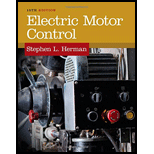
Electric Motor Control
10th Edition
ISBN: 9781133702818
Author: Herman
Publisher: CENGAGE L
expand_more
expand_more
format_list_bulleted
Concept explainers
Textbook Question
Chapter 48, Problem 1SQ
In Figure 48–2, what is the purpose of normally closed contact F?
Expert Solution & Answer
To determine
Explain the scope of normally closed (NC) contact (F) in Figure 48-2.
Explanation of Solution
Refer to Figure 48-2 in the textbook shows that plugging the motor to stop from one direction only. In this figure, the normally closed (NC) contact F is mentioned as an interlock.
In Figure 48-2, while the stop button is pressed, the forward contactor will drop out and the coil (F) is a de-energized normally closed (NC) contact F. This contact in turn, energizes coil (R) to operate the motor in the reverse direction through the closed plugging switch.
Conclusion:
Thus, the scope of normally closed (NC) contact (F) in the given figure is explained.
Want to see more full solutions like this?
Subscribe now to access step-by-step solutions to millions of textbook problems written by subject matter experts!
Students have asked these similar questions
2) Design the circuit shown in Figure 2 to provide bias current of IQ2= 150 uA.
Assume circuit parameters of IREF2 = 250 UA, V+ = 3 V, and V = -3 V. The
transistor parameters are VTP = -0.6 V, λ = 0, K'p= 40 uA/V², W/Lc = 15 and
W/LA = 25.
V+
Mc
+
VSGC VSGB
+
MB
VSGA
+
+
MA VSDA
IREF2
V-
Figure 2
ww
RD=8kQ
٣/١
a
い
يكا
+91- PU + 96852
A. For the RL-circuit with i(0)=0, Find the current i(t) using LT
R=2
V(t)=sin3t
L=1H
B. Find Invers Laplace Transform for Z(s) =
=
220125
750 x2.01
4s2 +2s+3
s2-3s+2
1) Taking base current into account, determine the value of I copy in each circuit depicted in Fig
1. Normalize the error to nominal value of Icopy.
REF
Vcc
AE
Vcc
QREF
Figure 1- a
I copy
5AE
REF
12
Q₁
copy
Q2
5AE
2AE
ЗАЕ
QREF
Figure 1-b
Chapter 48 Solutions
Electric Motor Control
Ch. 48 - In Figure 482, what is the purpose of normally...Ch. 48 - Can a time-delay relay be used satisfactorily in a...Ch. 48 - Prob. 3SQCh. 48 - Prob. 4SQCh. 48 - Prob. 5SQCh. 48 - What is the purpose of the lockout relay or safety...Ch. 48 - What happens if the reverse push button is closed...Ch. 48 - Prob. 8SQCh. 48 - Prob. 9SQCh. 48 - In Figure 487, is it necessary to push the stop...
Knowledge Booster
Learn more about
Need a deep-dive on the concept behind this application? Look no further. Learn more about this topic, electrical-engineering and related others by exploring similar questions and additional content below.Similar questions
- 12.2 Evaluate each of the following integrals. (a) G₁: = = √ (31³ +21² + 1) [8(t) +48 (t − 2)] dt -21 (b) G₂ = G2 = 4(e¯2ª +1)[☎(t) −28(t − 2)] dt -2 -20 (c) G3 = 0 3( cos 2π- 1) [8(t) +☎(t − 10)] dt -20arrow_forward3) The differential amplifier in Figure 3 is biased with a three-transistor current source. The transistor parameters are ẞ= 100, VBE (on) = 0.7 V, and VA = ∞. a) Determine I1. Ic2, IC4, VCE2, and VCE4. b) Determine a new value of R1 such that VCE4 = 2.5V. what are the values of Ic4, Ic2, I1, and R₁? +5 V Q1 R₁ = 8.5 ΚΩ IC4 23 RC= • 2 ΚΩ + 24 VCE4 RC= 2 ΚΩ est Ic2 + Q2 VCE2 -5 V Figure 3arrow_forward12.1 Evaluate each of the following integrals: (a) G₁ = √(33-4t²+3)[8(t) +28(t − 2)] dt. (b) G₂ = √442(e³ +1)[8(t) − 28(t − 2)] dt. .16 -31 (c) G3=124t sin(2лt) − 1][§(t − 1) +☎(t − 6)] dt.arrow_forward
- Why is the voltage drop of a self-excited generator greater than the voltagedrop of a separately excited generator?arrow_forwardWhen driving a DC shunt generator with a synchronous prime mover motor, why does the AC amperage to the synchronous motor machine increase as load is added to the generator?arrow_forward100 What is the phase and gain margins of the following system, is it stable or not. Design a PI controller for the following unstable process if any. 50 -120 -130 0 -140 -50 -150 -100 -160 <<-150 -170 -200 -180 10-1 10° 10¹ 102 103 104 105 1071 10° 10¹ 102 103 101 105 Frequency (rad/s) Frequency (rad/s)arrow_forward
- Please assist in the below questionarrow_forwardA. For the RL-circuit with i(0)=0, Find the current i(t) using LT R=2 Ω V(t)=sin3t B. Find Invers Laplace Transform for Z(s) L= 1H 4s2 +2s+3 = s2-3s+2arrow_forwardGiven the circuit diagram in. Find the following voltages: Vda, Vbh, Vgc, Vdi, Vfa, Vac, Vai, Vhf, Vfb, and Vdc.arrow_forward
- L ✓ 30 UF 2mtt The voltage applied across 3-branched circuit of figure 2 is given by v = 100 sin(5000t+ π/4). Calculate the branch currents and total current. v 25ŹR 00arrow_forward10 mA 2 ΚΩ 2 ΚΩ 6 ΚΩ x + ww 4 ΚΩ 4 ΚΩ +1 2 Varrow_forwardFind Vx,V1,V3,V0 according to the case of the circuits using KVLarrow_forward
arrow_back_ios
SEE MORE QUESTIONS
arrow_forward_ios
Recommended textbooks for you

 Electricity for Refrigeration, Heating, and Air C...Mechanical EngineeringISBN:9781337399128Author:Russell E. SmithPublisher:Cengage Learning
Electricity for Refrigeration, Heating, and Air C...Mechanical EngineeringISBN:9781337399128Author:Russell E. SmithPublisher:Cengage Learning EBK ELECTRICAL WIRING RESIDENTIALElectrical EngineeringISBN:9781337516549Author:SimmonsPublisher:CENGAGE LEARNING - CONSIGNMENT
EBK ELECTRICAL WIRING RESIDENTIALElectrical EngineeringISBN:9781337516549Author:SimmonsPublisher:CENGAGE LEARNING - CONSIGNMENT


Electricity for Refrigeration, Heating, and Air C...
Mechanical Engineering
ISBN:9781337399128
Author:Russell E. Smith
Publisher:Cengage Learning

EBK ELECTRICAL WIRING RESIDENTIAL
Electrical Engineering
ISBN:9781337516549
Author:Simmons
Publisher:CENGAGE LEARNING - CONSIGNMENT
Diodes Explained - The basics how diodes work working principle pn junction; Author: The Engineering Mindset;https://www.youtube.com/watch?v=Fwj_d3uO5g8;License: Standard Youtube License